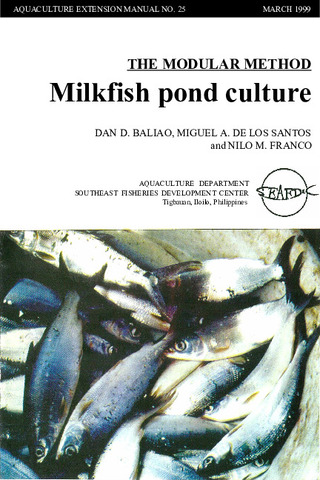On the induced spawning and larval rearing of milkfish, Chanos chanos (Forskal)
| dc.contributor.author | Liao, I-Chiu | |
| dc.contributor.author | Juario, Jesus V. | |
| dc.contributor.author | Kumagai, S. | |
| dc.contributor.author | Nakajima, H. | |
| dc.contributor.author | Natividad, Marietta | |
| dc.contributor.author | Buri, P. | |
| dc.date.accessioned | 2012-08-13T05:35:08Z | |
| dc.date.available | 2012-08-13T05:35:08Z | |
| dc.date.issued | 1979 | |
| dc.identifier.citation | Liao, I.-C., Juario, J. V., Kumagai, S., Nakajima, H., Natividad, M., & Buri, P. (1979). On the induced spawning and larval rearing of milkfish, Chanos chanos (Forskal). Aquaculture, 18(2), 75–93. https://doi.org/10.1016/0044-8486(79)90021-8 | en |
| dc.identifier.issn | 0044-8486 | |
| dc.identifier.uri | http://hdl.handle.net/10862/1023 | |
| dc.description | Contribution No. 35 of the Aquaculture Department, SEAFDEC. | en |
| dc.description.abstract | A female milkfish, captured at sea, was injected with two hormonal injections of acetone-dried salmon pituitary powder and human chorionic gonadotropin, plus Vitamin B complex. It was stripped, and produced 128,000 ripe eggs with an average diameter of 1.15 mm. Fertilization rate was 38% following artificial fertilization with milt from an uninjected male. A total of 36,000 larvae hatched (74% of fertile eggs) after 26–32 h at 34 ‰ salinity and 27–32°C. The newly hatched larvae measured 3.4 mm in mean total length and possessed a large yolk sac. The mouth of the larvae opened about 54 h after hatching. The larvae were fed with fertilized oyster eggs, rotifers, copepods, brine shrimp, flour and prepared feed, together with Chlorella. A critical period was between the 4th and 6th days with mortality over 80%. The larvae started increasing in length by Day 8, and had the appearance of the wild fry by Day 11. On Day 13 a pigmentation pattern developed and the biggest larva measured 10.0 mm. By Day 18 the larvae measured 12.5 mm, and 14.5 mm by Day 21. A total of 2,859 fry was obtained; the highest larval survival rate obtained from different experimental groups was 46.8%. | en |
| dc.language.iso | en | en |
| dc.publisher | Elsevier | en |
| dc.subject | Chanos chanos | en |
| dc.title | On the induced spawning and larval rearing of milkfish, Chanos chanos (Forskal) | en |
| dc.type | Article | en |
| dc.identifier.doi | 10.1016/0044-8486(79)90021-8 | |
| dc.citation.volume | 18 | |
| dc.citation.issue | 2 | |
| dc.citation.spage | 75 | |
| dc.citation.epage | 93 | |
| dc.citation.journalTitle | Aquaculture | en |
| dc.subject.asfa | induced ovulation | en |
| dc.subject.asfa | rearing techniques | en |
| dc.subject.asfa | fish culture | en |
| dc.subject.asfa | brackishwater aquaculture | en |
| dc.subject.scientificName | Chanos chanos |
Files in this item
| Files | Size | Format | View |
|---|---|---|---|
|
There are no files associated with this item. |
|||
This item appears in the following Collection(s)
-
Journal Articles [1256]
These papers were contributed by Department staff to various national and international journals.



